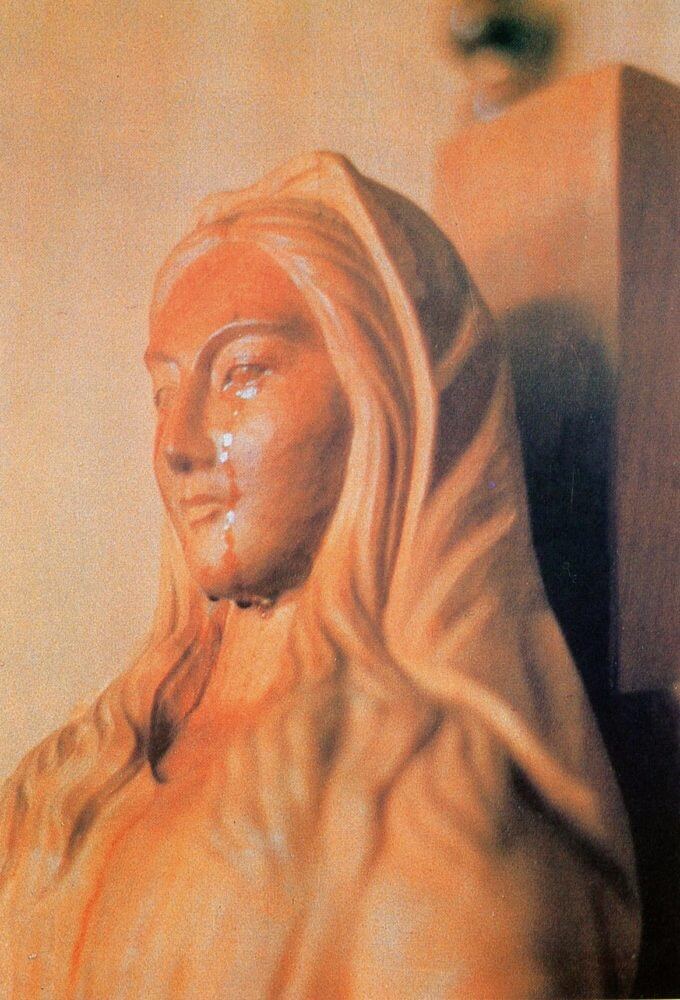Our Lady of Akita (partially found television broadcast of Mariana apparition; 1979)
Photograph of the crying statue. It is unknown if it is from the same event.
Status: Partially found
Our Lady of Akita is a title given by the Catholic Church to a statue of the Virgin Mary located in the town of Yuzawadai, Akita Prefecture, Japan.
Sister Agnes Katsuko Sasagawa claimed that she had been visited by the Virgin Mary and an angel from June 6, 1973 to 1981, receiving prophetic messages. After these apparitions, the wooden statue in the church began to cry what appeared to be sweat, tears or blood. The statue cried 101 times from 1975 to 1981.
The case of Our Lady of Akita is exceptional because the television network Channel 12 Tokyo broadcast the crying of the statue live on December 8, 1979, and it was retransmitted on various news programs in Japan.[1][2] The full recording, however, has not been found.
Background
On June 6, 1973, Sister Agnes Katsuko Sasagawa, from a small Catholic convent in the remote village of Yuzawadai, Japan, claimed that the Virgin Mary appeared to her and asked her to pray the rosary. After the apparition, she and the other sisters saw that a strange bleeding cross-shaped mark appeared on the right hand of the wooden statue of the Virgin Mary on the altar. The same mark also appeared on Sister Sasagawa's hand.[1] On June 12, according to Sasagawa, an angel appeared to her and asked her to pray in front of the statue. After this, Sasagawa partially regained hearing in her right ear. Medical examinations concluded that she regained full hearing in her ear in 1982.[3]
The next important event occurred on January 4, 1975, when people in the village testified that the statue began to cry human tears. The statue cried three times that day. After that event, the statue cried on more occasions: once more in 1975, six times in 1976, twelve in 1978, seventy-four times in 1979, and four times in 1981.[2]
The recording
In the book "Akita: The Tears and Message of Mary," Father Teiji Yasuda recounted that he was contacted by TV Tokyo to discuss the paranormal events surrounding the weeping statue. On December 6, 1979, the TV station sent four cameras and several technicians under Mr. Yama'uchi's command to conduct the interview on December 7 for broadcast on the Feast of the Immaculate Conception.[3] According to Father Yasuda, a few minutes after midnight on December 8, the phone in his room rang and a sister informed him that the statue had begun to cry. When he arrived at the chapel, cameramen immediately burst in to record and photograph the event.[3]
Mr. Yama'uchi and his cameramen regretted that they had not been able to record the crying from the start. That is why they proceeded to set up a fixed camera facing the statue. Filming began at 8:00 p.m. on December 8.[3] A few minutes after 11 p.m., a sister who was praying in front of the altar informed the cameramen that the statue had started crying again. The whole event was recorded by the fixed camera and photographed by the other technicians, who also recorded with their respective cameras.[3]
In 1984, the Catholic Church approved the apparition, becoming one of the few Marian apparitions recognized by the Holy See.
Status
Not much is known about the full video of the statue crying. According to one source, the recording is still in position in the chapel.[2] It is known that the footage was broadcast on television several times; For example, on July 19, 1988, it was shown on the famous EWTN program Mother Angelica Live while an interview was being conducted with Bishop John Ito.[4]
However, almost nothing has emerged from the recording, including the Mother Angelica Live broadcast. The only available footage is a few short clips shown in a 1990 documentary, without specifying whether they belong to the first or second cry on December 8.
Gallery
References
- ↑ 1.0 1.1 Our Lady of Akita
- ↑ 2.0 2.1 2.2 A Scientifically Proven Miracle! Amazing Weeping Statue of Virgin Mary: The Miracle of Our Lady of Akita
- ↑ 3.0 3.1 3.2 3.3 3.4 Akita: The Tears and Message of Mary by Father Teiji Yasuda
- ↑ UCA News - CARDINAL RATZINGER SAID TO APPROVE MESSAGES OF BLESSED MOTHER AT AKITA.
